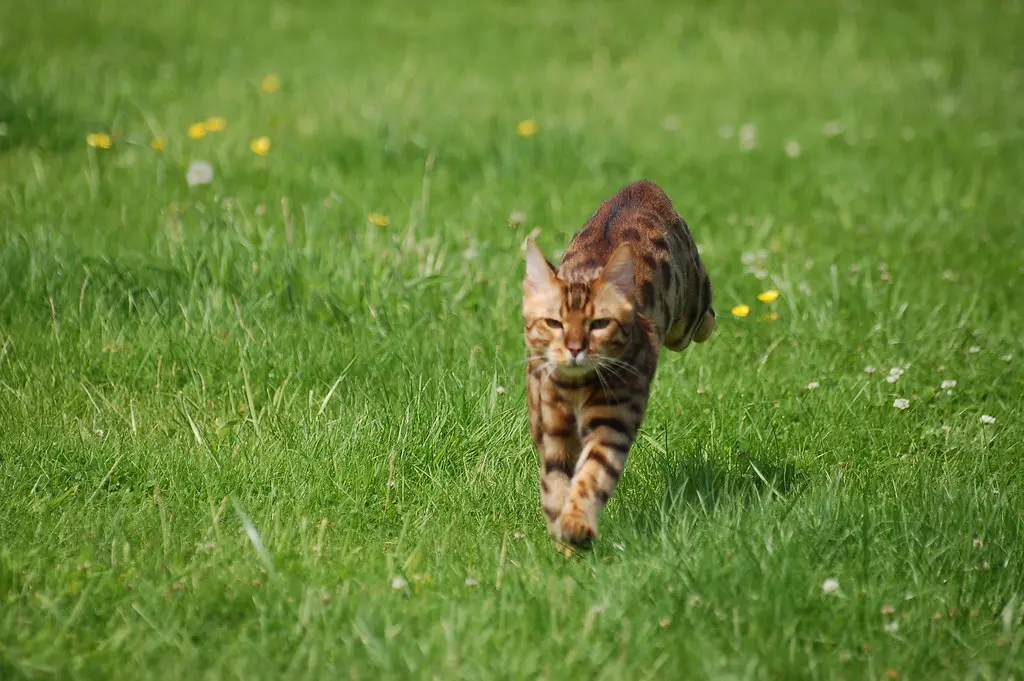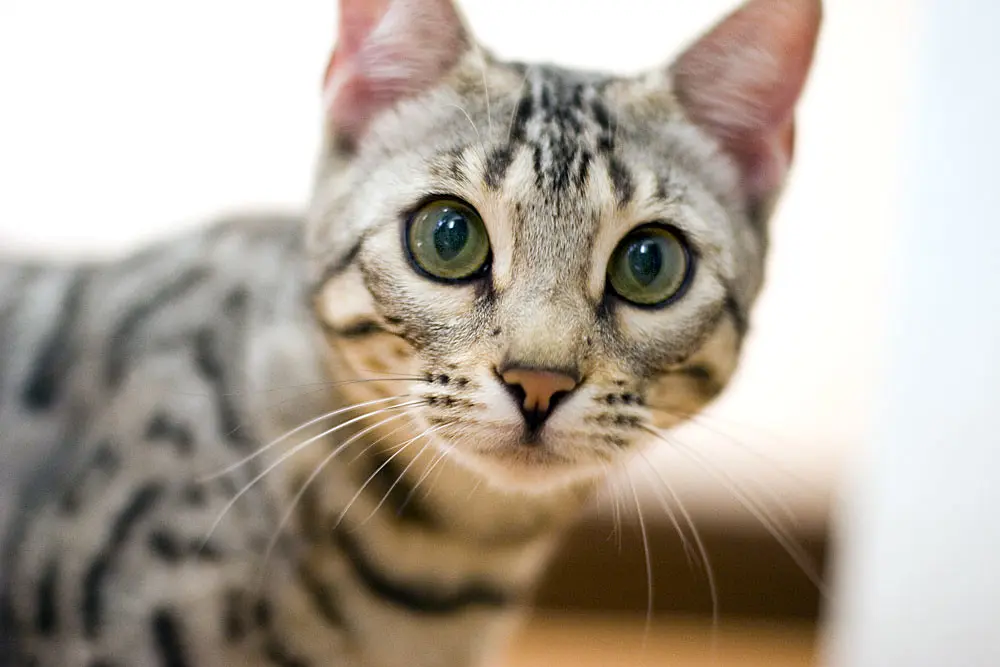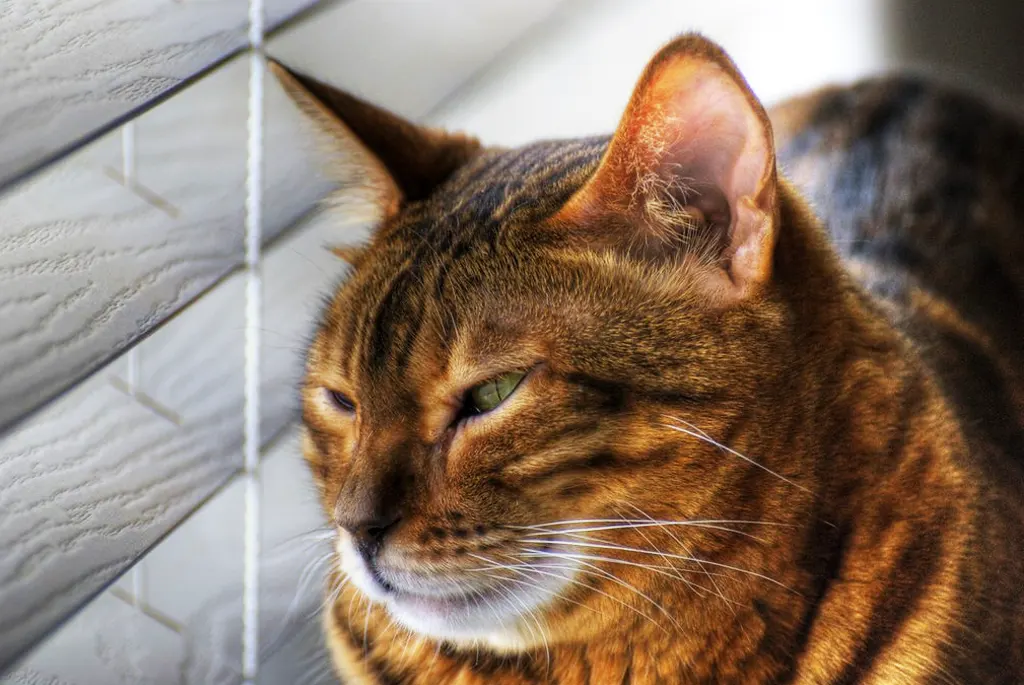Bengal cats are a unique breed that has gained popularity in recent years due to their striking appearance and inquisitive personalities. Originating from the hybridization of domestic cats with the Asian leopard cat, Bengal cats possess a distinct set of physical and behavioral traits that set them apart from other feline counterparts.
In this comprehensive study, we will explore all aspects of Bengal cats, from their history and physical characteristics to their temperament and lifestyle requirements. Each section will dive deep into the details, giving you a thorough understanding of this unique breed.
 The Bengal Cat At A Glance
The Bengal Cat At A Glance
Family: Felidae
Class: Mammalia
Lifespan: 15-20 years
Length: 22-25 inches (male), 18-20 inches (female)
Weight: 8-15 pounds (male), 6-12 pounds (female)
Energy Level: High
Personality: Energetic, intelligent, playful, social
Temperament: Curious and outgoing
Intelligence: Highly intelligent, capable of learning intricate tasks
History

Bengal cats are a relatively new breed created by crossing Asian Leopard Cats with domestic cat breeds. The earliest known mention of this crossbreed was in 1889 when Harrison Weir wrote about them in “Our Cats and All About Them. However, it wasn’t until the 1950s and 1960s that this crossbreeding really gained popularity. In the early 1970s, a woman named Jean Mill created the modern Bengal breed by crossing a female Asian Leopard Cat with a male domestic cat.
These hybrid cats were initially bred for their unique appearance, which includes a wild-looking coat and distinctive spots and stripes. They quickly gained popularity as pets due to their energetic personalities and affectionate nature. Today, Bengal cats are recognized as a distinct breed by the Cat Fanciers’ Association and are enjoyed as pets by many cat lovers.
The Cost
The cost of a Bengal cat can range significantly based on several factors including the breeder, lineage, and coat quality. On average, they can cost from $1,000 to $5,000.
Behavioral Traits

- Love for Water:
Bengal cats are known for their love of water. They are often fascinated by running water, such as taps, fountains, or even splash around in their water bowls. This behavior stems from their wild ancestors who were excellent swimmers. So, don’t be surprised if your Bengal cat follows you into the shower or enjoys playing with water. - High Energy Levels:
Bengal cats have a reputation for being high-energy felines. They require plenty of physical and mental stimulation to stay healthy and happy. This means lots of interactive playtime with their owners and toys that encourage exercise and mental agility. - Social Creatures:
Bengal cats are naturally curious and love to socialize. They enjoy being around people, and their vocalization means they are not shy about initiating contact. They are also playful, and their high energy levels make them a joy to be around. - Affectionate:
Bengal cats form deep bonds with their owners and enjoy spending time with them. Although not lap cats, they are affectionate and like to be close to their owners. They will often follow them around the house and enjoy cuddling and playing. - Hunting Instincts:
Bengal cats have a highly developed hunting instinct, which means they may attempt to “hunt” other pets in the home or toys in their environment. This behavior requires providing lots of physical and mental stimulation and cat-proofing the home environment to prevent any damage. - Vocalization:
Bengal cats are vocal felines, constantly meowing, chirping, and purring. They use vocalization to communicate with their owners, especially when they want attention or food. - Athleticism:
Bengal cats are athletic and love to climb and jump. They enjoy perching at high vantage points and observing their surroundings. Providing them with climbing structures and scratching posts can satisfy this natural behavior. - Curiosity:
Finally, Bengal cats are highly curious felines that enjoy exploring their environment. They will often investigate new toys or objects and can even figure out how to open doors or cabinets. It’s important to provide them with plenty of mental stimulation and cat-proof the home to ensure their safety.
Appearance

Size and Body Structure
Bengal cats are generally medium to large in size. They have a robust and muscular body, a clear testament to their wild roots. Their back limbs are slightly longer than the front ones, giving them an appearance of agility, which they also possess.
Coat
The Bengal cat’s coat is probably its most well-known feature. These felines are appreciated for their incredible, soft fur that shimmers in the light.
Colors
The Bengal cat’s coat, similar to a leopard’s, can come in a plethora of hues ranging from golden, cream, ivory, to even charcoal. But the most typical colors are orange to light brown, and on rare occasions, you might spot them in a blue shade!
Patterns
Their coat can sport two types of patterns: spotted and marble. Yet, most commonly, Bengals have a spotted coat which is typically a mixture of dark spots on a lighter background.
Distinctive Markings
Another feature, unique to Bengal cats, is a pattern known as ‘rosettes’ — large spots that look more like rings or are comprised of a color different from the sheen of their coat, just like their wild counterparts – the leopards and jaguars.
Eyes
Their eyes vary in color from green, blue, or gold. They are often round and wide, adding to their alert and curious look, ready for any kind of mischief!
Ears
They have small to medium-sized ears which are wide at the base and rounded at tips. Compare them to a wild cougar’s ears, and you will quickly spot the resemblance.
Diet & Nutrition

Their Carnivorous Nature
Just like their wild ancestors, Bengal cats are obligate carnivores, implying they predominantly rely on animal-based protein. It’s instrumental to keep this instinctual habit of theirs in mind while planning their food regimen. Provide them with a diet rich in quality proteins, as plant proteins lack certain essential amino acids the cat needs.
Diet Types for Bengal Cats
Now that we’re aware of their carnivorous side, let’s explore different diet types that can cater to Bengal cats’ requirements:
Commercially Available Cat Food
A high-quality, commercially available cat food that has real meat identified as the first ingredient can be an excellent choice. This ensures protein provision and the necessary nutrients that a Bengal cat needs.
Raw Feeding
Feeding raw food, potentially mimicking their wild diet, might be another way to go. An array of natural whole foods such as chicken, fish, and certain vegetables can offer them nutrition as nature intended.
Homemade Diet
If you opt to cook for your cat at your home, remember to incorporate quality meat along with additional supplements necessary to complete their nutritional picture.
Essential Nutrients
Let’s discuss the specific nutrients that are vital for Bengal cats:
High Protein Requirements
Bengal cats are energetic and muscular, requiring a diet rich in protein. Not only does protein provide the necessary energy, but it also helps in muscle development and body tissue repair. The primary source of protein should ideally come from real meat such as chicken, beef, or fish. Many commercial cat foods labelled as high-protein often use plant-based proteins which are not as beneficial for cats, as they are obligate carnivores and require certain nutrients only found in meat.
Fats
Healthy fat sources such as fish oil, flaxseed oil, or chicken fat can support their skin and coat health.
Amino Acids
Remember, cats cannot produce certain essential amino acids. So, including quality animal protein assures they get these crucial nutrients.
Vitamins & Minerals
Vitamins and minerals support various bodily functions in Bengal cats. Look for cat food that ensures these micronutrients are adequately supplied.
Hydration
Another key aspect of a Bengal cat’s diet is hydration. Given their unique liking for water, Bengals need to stay well-hydrated. Cat fountains are popular among Bengal cat owners as these cats enjoy the flowing water, encouraging them to drink more. The adequate water intake can help in preventing urinary tract issues often common in cats.
Supplementary Nutrients
Just like other cats, Bengals benefit greatly from a balanced diet. Apart from proteins, healthy fats and carbohydrates are also necessary. Vitamins and minerals that support healthy skin, coat, eyesight, and boost their immune system should also be included.
Health Issues in Bengal Cats

Genetic Health Risks
Bengal cats, like many purebred animals, are at risk for certain genetic health issues. One common health concern is hypertrophic cardiomyopathy (HCM), a type of heart disease that is often hereditary in Bengals. Regular screening tests are essential for early detection of this disease.
Progressive Retinal Atrophy (PRA)
Progressive Retinal Atrophy (PRA) is a debilitating disease that gradually reduces your cat’s vision until they are completely blind. It most commonly begins when your Bengal cat is around 2 years old due to the deterioration of photoreceptor cells in their retina.
Gastrointestinal Conditions
Bengal cats are prone to suffer from gastrointestinal upsets, possibly due to their curious nature which often leads them to nibble on things they shouldn’t.
Eye and Dental Problems
Health conditions including glaucoma, myopia, corneal sequestra, cataracts, conjunctivitis, and uveitis can affect Bengal cats. Another common problem Bengal cats may face is dental disease. Like most cats, Bengal cats are unable to take care of their own teeth, ergo, the chance of developing dental disease is high unless their owner helps manage their dental hygiene.
Lower Eyelid Entropion
Lower eyelid entropion is another issue which can irritate the cornea and cause ulcers, scratches, inflammation, discharge, and pain.
Chronic Renal Failure
Chronic Renal Failure (CRF) is a common health problem found in all breeds of cats, including Bengals. Recently, there seems to be an increase in the number of Bengals diagnosed with this health condition.
Regular Health Checks
Regular vet visits are crucial for Bengal cats’ overall health. Professionals can check for common health issues like dental disease, obesity, allergies, and parasitical infections. Aside from regular vaccination and deworming schedules, Bengals may need additional check-ups or screenings for specific health concerns.
Housing Options for Bengal Cats
Indoor Living
While Bengals are highly adaptable, they are generally better suited to living indoors. This is due to several reasons such as potential road accidents, fights with other animals, infectious diseases, and risk of theft (given their expensive price). Their curious and active nature means that Bengals are always inclined to explore. If let outdoors unattended, they can potentially get themselves into trouble.
Enriched Environment
A Bengal cat’s housing isn’t complete without enrichment. Their playfulness and curiosity need to be met with stimulating toys and cat furniture. Climbing trees, scratching posts, interactive toys, and hideaways are all excellent additions. Cat shelves or window perches can also satisfy their love for climbing and observing from a height.
Secure Outdoor Access
If you decide to provide your Bengal cat with outdoor access, it should be a secure, contained area like a cat patio (or ‘catio’), or an enclosed garden. Using cat harnesses for outdoor walks can also be an option, but this requires training and constant supervision to ensure their safety.
In the end, whether the housing is indoors or outdoors, the important thing is to provide them with enough mental and physical stimulation. A bored Bengal cat can lead to destructive behavior, so enriching their environment is key.
Breeding
When it comes to breeding Bengals, there are several key considerations prospective breeders need to observe. Successful breeding goes beyond merely pairing two Bengals together; it requires a deep understanding of the breed, proper health assessments, and responsible rearing practices.
Understanding The Cat’s Generations
Bengal cats are categorized by the ‘filial’ number, which represents how many generations they are removed from their wild Asian Leopard Cat ancestor. F1 Bengals, for instance, have an ALC as one parent, while an F2 Bengal has an ALC grandparent, and so forth. Understanding these generations is crucial because it plays into the cats’ behavior and temperament, as well as defining legal breeding and ownership in some places.
Genetic Screening
Before embarking on breeding, all potential parent cats should be screened for genetic diseases. As previously mentioned, Bengals can be predisposed to certain hereditary diseases like hypertrophic cardiomyopathy (HCM) and progressive retinal atrophy (PRA). Screening allows breeders to avoid reproducing these diseases in kittens, striving for a healthier breed overall.
Selecting Suitable Mates
When selecting mates, breeders look beyond just the health of the cats. They also consider the cats’ patterns, temperaments, and pedigrees. Proper mate selection can help maintain and improve the breed standard over time.
Breeding Practices
Responsible breeders usually allow female Bengals to breed from the age of 18 months and limit the number of litters a queen (female cat) has in her lifetime for her health and well-being. It’s crucial for the queen to have a comfortable and secure place to give birth and rear her kittens.
Caring for Kittens
After birth, the kittens must be properly cared for and socialized to ensure they grow into happy, healthy, and friendly adult cats. They are typically weaned from the age of 6 weeks and, in most cases, ready to leave for their new homes at around 12 weeks. Before they are homed, reputable breeders also make sure that kittens are vaccinated and appropriately vetted.
Responsibility to New Owners
The breeders’ responsibility doesn’t end once the kittens are sold. Reputable breeders provide ongoing support to new owners, helping them understand the specific dietary and care requirements of Bengal cats.
In conclusion, breeding Bengal cats is a complex process that requires knowledge, dedication, and a commitment to the health and happiness of the breed. It’s not something to be undertaken lightly, but when done properly, it can contribute positively to this wonderful breed.
Fun Facts About Bengal Cats
Here are 10 fun facts about Bengal cats:
- Bengal cats have wild origins and were created by breeding wild Asian leopard cats with domestic cats.
- Jean Sudgen Mill first bred Bengal cats in the 1960s, and the breed was officially recognized by the International Cat Association in 1991.
- Bengal cats have a hybrid origin; they are the result of crossbreeding between a male domestic cat and a female Asian leopard cat.
- Bengals are known for their boundless energy and are always alert to play.
- Unlike many other domestic felines, Bengal cats enjoy water and are often thankful for a dip in the tub.
- The breed was first established in the 1980s by Jean S. Mill of California, making it a relatively new breed compared to other pure breeds.
- Bengal cats are a result of crossing a Domestic Shorthair with an Asian Leopard cat.
- Bengal cats are highly intelligent and social, making them great pets for families and those who enjoy an interactive companion.
- They are known for their unique vocalizations, which are somewhat similar to those of their wildcat ancestors.
- Bengals are not only known for their striking appearance, but they are also very athletic cats, with an excellent jumping ability.
In conclusion, Bengal cats are an amazing breed, each with its unique quirks and personality. With the right care and environment, a Bengal cat can indeed be the perfect pet.
